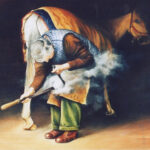Keeping a horse’s hoof healthy is vital to the overall well being of the horse. There are many different diseases and conditions that you will need to keep your eye open for and take immediate action to remedy the situation. If a horse is suffering with a hoof ailment, the whole animal will suffer. Horses depend on their legs, feet and hooves for every action they must do. They sleep, eat and drink all while standing so it is very important to maintain and repair their hooves.
Thrush or Canker is an infection of the frog. The frog is the soft padding on the underside of the horse’s foot. When the frog becomes infected it is known also as hoof rot. The main sign thrush is a foul odor coming from the underside of the foot as well as oozing discharge. The main cause of thrush is too much time spent in moist, muddy living conditions. To remedy the thrush, remove the horse from any moist conditions and apply a liquid medication that you can brush on. Most tack stores will supply this medication, but if you cannot find it you will need to contact your vet. If the condition does not improve after treatment, you will need to contact your veterinarian for further assistance. Thrush is a common problem that is easily treated, but if left alone will ruin the entire hoof.
Horses can also be affected by corns just as humans are. A corn is caused by any repetitive pressure that is applied to any part of the foot. The most common cause of a corn is a poor shoeing job. Similar to corns is a bruised sole. Bruised soles affect many horses, but primarily one with flat soles. A bruise may be caused by stepping on a hard object, even a piece of gravel. A trimming job that was done improperly may also cause the sole to lay too low to the ground and become bruised by the repetitive pressure from the ground. A corn or bruise should be remedied quickly so that the area does not abscess. Find out what is causing the corn and remove it or contact your farrier to inspect the hoof and shoe or re-trim if needed.
Abscesses are another common hoof ailment in horses. An abscess is a small hole in the hoof. Many times the horse will be fine one day and the next day you may find the horse unwilling to walk. An abscess generally will affect only one foot and will require a visit from your vet. The vet will drain the abscess and apply proper dressings. An abscess will take a long time to recover from so proper hoof cleaning will help to prevent any materials from entering the hoof and leading to corn, bruised soles and abscesses. An abscess may be caused from a hard blow to the hoof, or an untreated corn. Your vet will leave you with follow up instructions that will include daily cleaning and redressing of the hoof. The horse will most likely receive a tetanus vaccination as well.
Many times a horse’s hoof will crack. A crack at the base of the hoof is generally a result from dry hooves, or a horse spending too much time in muddy living conditions. The mud will weaken the hoof and lead to cracks. Small cracks at the bottom of the hoof will grow out on their own and generally do not require any treatment. A crack may also occur at the base or top of the hoof. These cracks are much more serious and are usually a result from an injury to the coronet, or base of the leg. A crack that appears to bleed or cause the horse to be uncomfortable will require a visit from the farrier and most likely a trim and shoe job.
Seedy toe is another hoof problem found in horses. Seedy toe is a condition in which the outside hoof wall becomes separate from the sensitive laminae found inside the foot. The hoof may look healthy from the outside, but when cleaning the hoof you will notice the inside is crumbly and appears to be falling apart. Seedy toe is most commonly caused by improper or lack of trimming the hoof. It is also associated with founder. Your farrier will help you treat the condition, but sometimes there may be no treatment options depending on the severity of the case of seedy toe.
Laminitis is mostly known as founder in a horse. When a horse is said to be in founder, it generally means the horse is lame and not ready for use. Laminitis is an inflammation of the foot that generally affects the front two feet of the horse. The most common cause is eating too much, or finding the grain bin and overeating of grain. Once a horse has been affected by laminitis it may never recover fully, so it is very important to manage your horse’s diet wisely. Some horses may be more sensitive to laminitis and founder easily. A horse can recover to a usable state with some careful treatment. You will need to have a vet visit and properly diagnose your horse and recommend the best treatment.
The last common cause of hoof pain is Navicular Disease. Navicular disease is a disease of the foot, not a condition. A horse that appears to be lame, but has no seen condition may be suffering from Navicular disease. It is caused by the degeneration of the navicular bone, which is a small bone that is inside the foot of the horse. There is no cure for this disease, but there are treatments that may help the horse to experience less pain. A vet and farrier can help you treat your horse that is experiencing pain from Navicular Disease.
So you can see that there are several conditions that may affect your horse’s hooves. Many can be prevented by proper cleaning, trimming and shawing of your horse. Be sure to maintain a 6-8 week trimming schedule and dry living conditions for your horse and you can successfully avoid any serious hoof problems in your horse!


